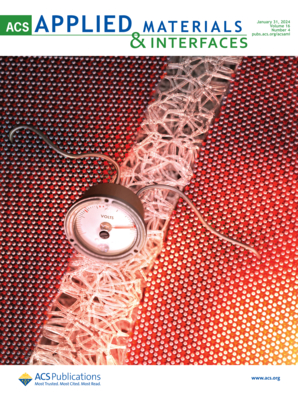用于高效电化学二氧化碳还原的具有分层多孔结构的掺氮碳单片电极
IF 8.3
2区 材料科学
Q1 MATERIALS SCIENCE, MULTIDISCIPLINARY
引用次数: 0
摘要
掺杂 N 的碳材料具有来源丰富、结构可塑性强、催化性能优异等特点,在电化学还原二氧化碳方面得到了广泛的发展。然而,使用粉末碳材料进行电催化反应会限制其电流密度和机械强度,这给工业应用带来了挑战。在本研究中,我们以酚醛树脂为前驱体,ZIF-8 为牺牲模板,通过简单的热解方法合成了一种具有高机械强度的掺杂 N 的整体碳电极,用于 CO2 到 CO 的高效电化学还原。900 °C 时,ZIF-8 的分解和 Zn 原子的挥发促进了碳基质中分层多孔结构的形成,这种结构的特点是具有扩展介孔通道的大孔。与此同时,ZIF-8 衍生的 N 活性物种在孔隙周围有效生成并充分暴露。分层多孔结构和暴露在外的高活性氮元素促进了有效的传质,从而实现了二氧化碳到一氧化碳的高效转化。当 ZIF-8 含量为 30% 时,催化剂在 -0.7 V 的低电位(相对于 RHE)下对 CO 的法拉第效率达到 88.9%,CO 生成率为 244.05 μmol h-1 cm-2。静电电解 50 小时后,电流密度和 FECO 保持稳定。这项工作不仅为分层多孔结构和氮掺杂的协同效应提供了一种策略,还为避免使用粉末粘合剂和制备集成稳定的整体电极提供了一种有效方法。本文章由计算机程序翻译,如有差异,请以英文原文为准。

Monolithic Nitrogen-Doped Carbon Electrode with Hierarchical Porous Structure for Efficient Electrochemical CO2 Reduction
N-doped carbon materials have garnered extensive development in electrochemical CO2 reduction due to their abundant sources, high structural plasticity, and excellent catalytic performance. However, the use of powder carbon materials for electrocatalytic reactions limits their current density and mechanical strength, which pose challenges for industrial applications. In this study, we synthesized a monolithic N-doped carbon electrode with high mechanical strength for efficient electrochemical reduction of CO2 to CO through a simple pyrolysis method, using phenolic resin as the precursor and ZIF-8 as the sacrificial template. At 900 °C, the decomposition of ZIF-8 and the volatilization of Zn atoms promote the formation of a hierarchical porous structure in the carbon matrix, characterized by macropores with extended mesoporous channels. Simultaneously, N active species derived from ZIF-8 are effectively generated around the pores and fully exposed. The efficient mass transfer facilitated by the hierarchical porous structure and high activity of exposed nitrogen species enables efficient conversion of CO2 to CO. When the ZIF-8 content is 30%, the catalyst achieves a Faradaic efficiency of 88.9% for CO at a low potential of −0.7 V (vs RHE), with a CO production rate of 244.05 μmol h–1 cm–2. After 50 h of potentiostatic electrolysis, the current density and FECO remain stable. This work not only provides a strategy for the synergistic effects of hierarchical porous structures and nitrogen doping but also offers an effective method to avoid using powder binders and prepare integrated, stable monolithic electrodes.
求助全文
通过发布文献求助,成功后即可免费获取论文全文。
去求助
来源期刊

ACS Applied Materials & Interfaces
工程技术-材料科学:综合
CiteScore
16.00
自引率
6.30%
发文量
4978
审稿时长
1.8 months
期刊介绍:
ACS Applied Materials & Interfaces is a leading interdisciplinary journal that brings together chemists, engineers, physicists, and biologists to explore the development and utilization of newly-discovered materials and interfacial processes for specific applications. Our journal has experienced remarkable growth since its establishment in 2009, both in terms of the number of articles published and the impact of the research showcased. We are proud to foster a truly global community, with the majority of published articles originating from outside the United States, reflecting the rapid growth of applied research worldwide.
 求助内容:
求助内容: 应助结果提醒方式:
应助结果提醒方式:


